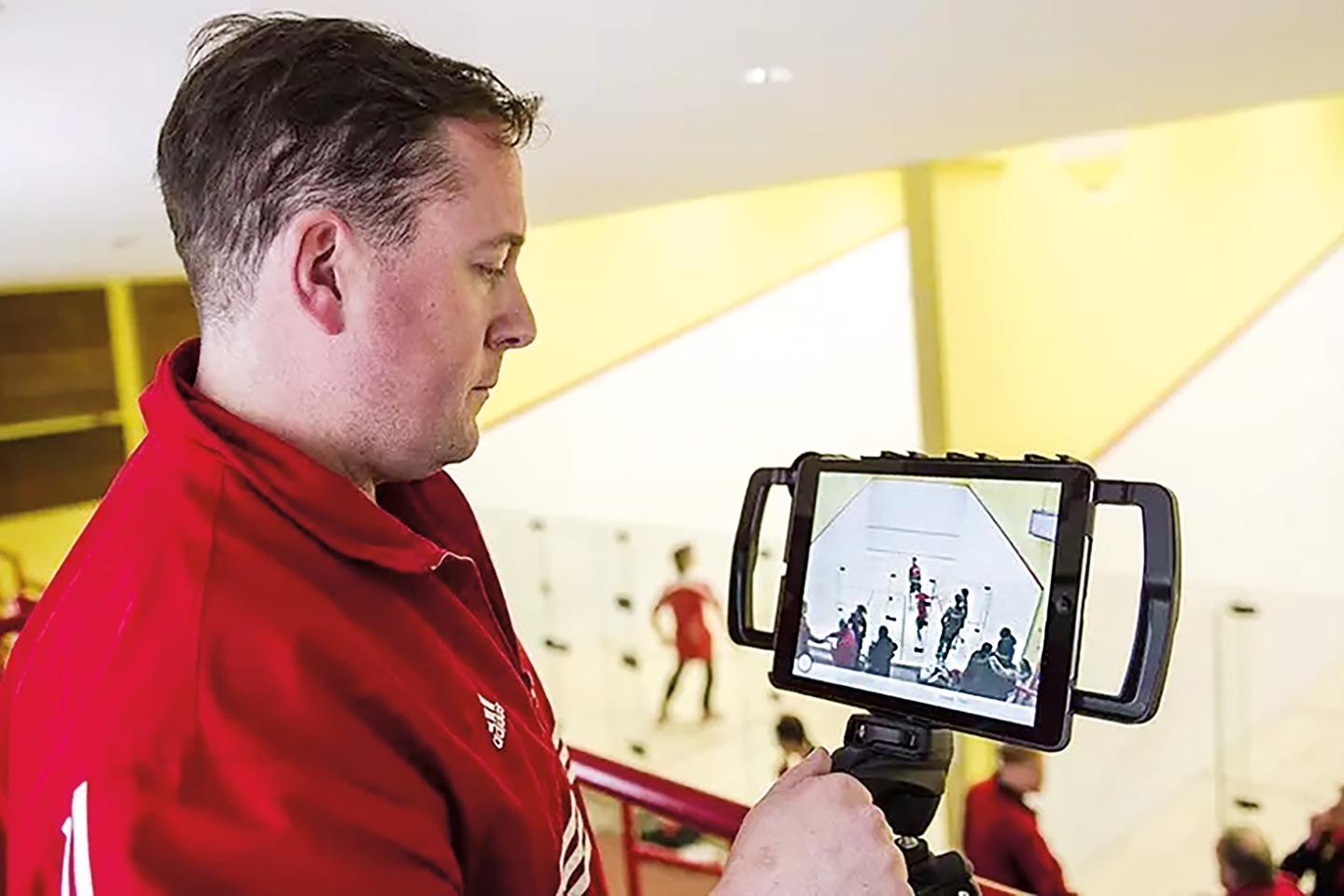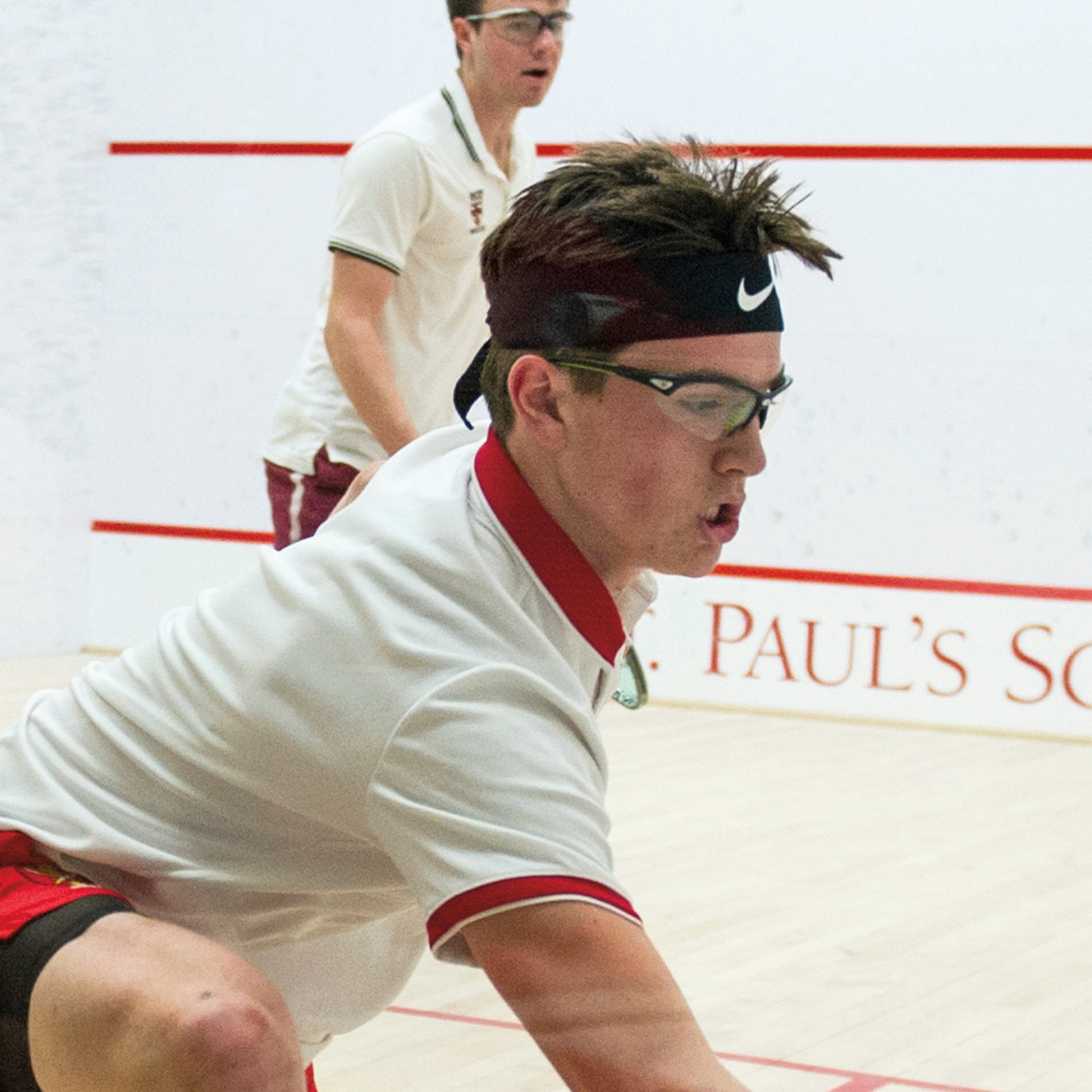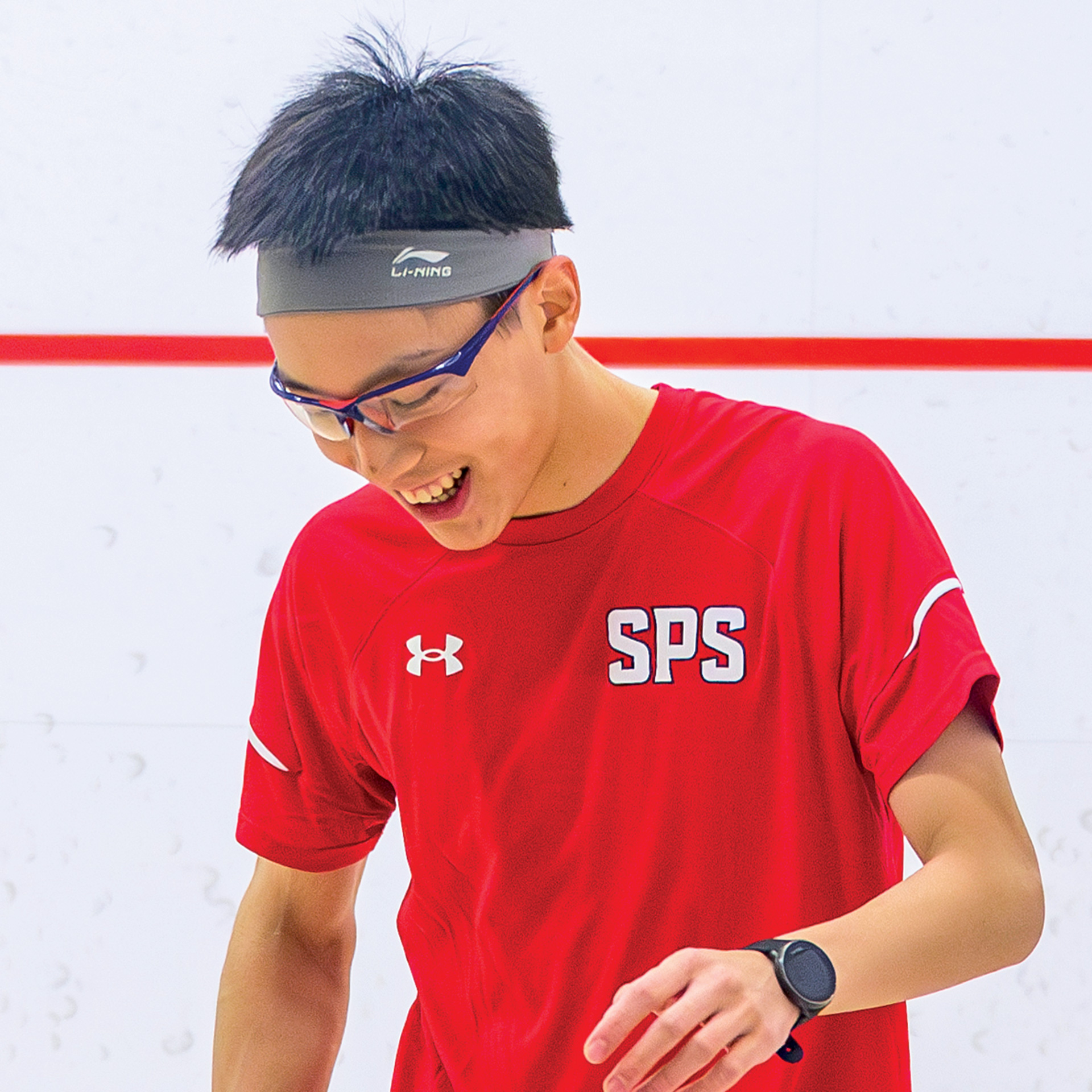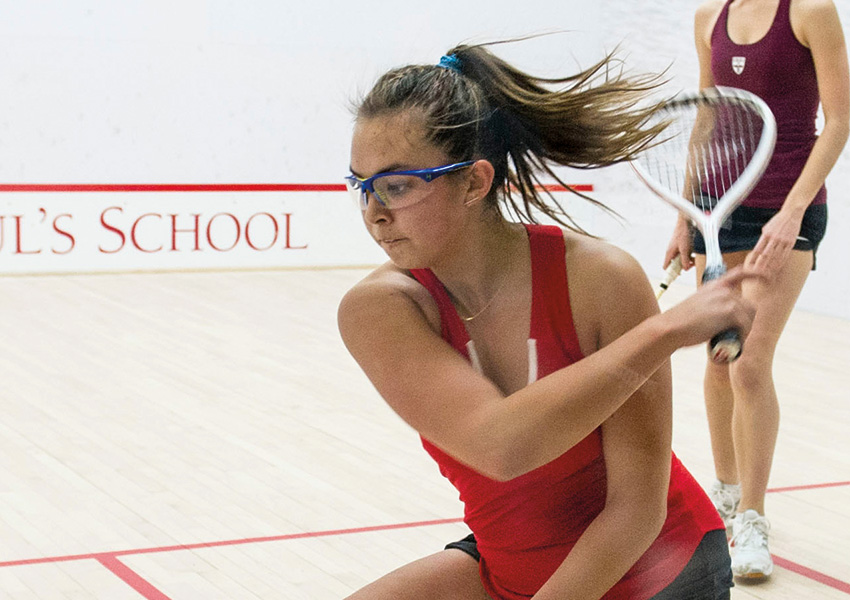At left Varsity Head Coach Chris Smith monitors multiple matches at the McLane Squash Courts.
Early planning is underway to construct a new state-of-the-art squash center that will be an extension of the Athletic and Fitness Center.
This article was originally published in the Summer 2024 issue of Alumni Horae.
St. Paul’s School and squash have been a perfect match for more than 140 years. Now, the School is poised to take its position in the sport to the next level.
BY IAN ALDRICH
In the fall of 2007, Chris Smith, then the men’s and women’s assistant squash coach at Harvard University, embarked on one of the most important recruitments of his young career: Will Ahmed ’08. In Ahmed, who a few months later would captain the St. Paul’s School boys squash team to its first New England Class A Championship in 18 years, Smith saw a potential anchor for his Harvard team. The fact that Ahmed had cut his competitive teeth at the oldest and one of the most prestigious high school squash programs in the country was a significant aspect of Smith’s interest in adding him to his own program.
Over the next several years, as Ahmed played for and ultimately captained the Crimson squad, Smith began to lay the groundwork for a different sort of recruitment: his own, to coach at SPS. “This wasn’t a case of me looking at five different prep schools and finding St. Paul’s to be better than the others,” says Smith, who’d previously been the founding coach of the Northeastern University squash program and head of the U.S. Junior National Team. “It was a direct target. With its amazing campus, its academics, its place among the boarding school landscape and its squash program, this is where I wanted to be.”
In the summer of 2014, Smith and his family left their lives in Medford, Massachusetts, and resettled in Millville. “Most college programs have one coach for both the men’s and women’s teams for a unified vision and that’s what I wanted to bring to St. Paul’s,” says Smith. “My whole pitch was: It doesn’t make sense for me to just work with half of the kids. Let me work with everyone and build a one-program mindset.”
In the decade since his arrival, Smith, who is head of Middle House and now the School’s athletic director, has raised the SPS program to new heights. The school’s two varsity teams are regularly among the best in the country, winning a host of New England Team Sportsmanship Awards and New England titles along the way. In 2015 and 2016, Smith was named to the U.S. Squash Top 50 Coaches list, the only high school coach to gain that honor in either year.
During that same time, Smith has also guided the modernization of the McLane Squash Courts, the school’s 10-court squash center originally built more than a century ago. The upgrades have included the addition of ball and stringing machines, bigger scoreboards, 4K live video streaming and an overhaul of the building’s audio system for drill-change announcements and all-important pump-up music for practices.

At left Varsity Head Coach Chris Smith monitors multiple matches at the McLane Squash Courts.
Early planning is underway to construct a new state-of-the-art squash center that will be an extension of the Athletic and Fitness Center.
But upgrading an aging building can only take you so far, and SPS is now plotting the next era of its decorated program. Early planning is underway to construct a new state-of-the-art squash center that will be an extension of the Athletic and Fitness Center. Beyond the School’s larger mission to centralize its sports facilities, the new building’s configuration will better accommodate the growing interest in SPS squash from players and fans alike.
The timing couldn’t be better. If the necessary funding is secured over the next year, the new center is expected to come online just as squash — which was recently added to the 2028 Summer Olympic Games in Los Angeles — is preparing for its moment in the spotlight.
“We really feel good about the timing of this for St. Paul’s and for the sport in general,” says Smith. “It’s going to transform the spectator experience for us here. It’s going to change the coaching experience. And the players are going to get the best learning experience possible. There’s a level of passion for squash at St. Paul’s, including the amazing alumni who are behind the program, and we want this new center to build on that.”

FROM THE ARCHIVES: The balcony of the “new” Squash-Racquet Courts of 1915.
THE COUNTRY’S FIRST COURTS
The curious history of squash begins in mid-19th century London, when bored Fleet Prison inmates turned old rubber balls into whackable ovals and started experimenting with slapping one after the next against the prison yard’s towering stone walls. Versions of the game eventually migrated to other communities, most notably the Harrow School, an all-male British boarding academy founded in 1572, where students used rackets and added a growing set of game rules to the sport.
In 1881, the game arrived in Millville thanks to the efforts of The Rev. James Potter Conover, Form of 1876, a sports enthusiast who had returned to teach at his alma mater after attending Columbia University with Hyde Clark, a Harrow graduate and avid squash player. Conover’s own love of the sport propelled School leaders to build the country’s first venue for squash that year: a “Racquets Court” building near Lower School Pond where the first games were played, and to which four open-air courts were appended in 1883. As demand for the courts increased, Maurice Roche, Form of 1905, the son of an English Lord and the future maternal grandfather of Princess Diana, donated funds for the construction of a series of indoor courts along Library Road in 1915 that are today known as the McLane Squash Courts.
SPS’s early embrace of squash spawned a dominance by alumni at the amateur ranks. Herb Rawlins of the Form of 1923, Larry Poole of the Form of 1924, Beekman Poole of the Form of 1928 and William Patterson of the Form of 1928 all won U.S. National titles — including back-to-back crowns for the younger Poole in 1932 and 1933.
Over the ensuing decades, SPS has remained at the center of amateur squash. In all, the program has captured 22 New England team and individual titles. Alumni have played for some of the nation’s most elite college programs, including Harvard, Cornell, Yale, Princeton, UVA, Columbia and MIT, among others, winning three college individual national titles and seven U.S. Squash national championships.
In “A Proud Tradition,” a history of squash at SPS by professional player Rob Dinerman that tracks the program from its earliest years to Smith’s arrival, the notion of legacy figures prominently. “The members of the current St. Paul’s varsity teams are torch-bearers of an immensely proud tradition that has had, and continues to have, an enormous influence on squash as it is played and governed throughout the county and indeed the world,” Dinerman writes. “Everyone who has ever wielded a racquet while representing SPS, or who has coached and/or taught those who have, whether in the heat of a varsity meet against a prep-school arch-rival or in any other setting, has added to and enriched that tradition.”
BEARING THE TORCH

As a student at St. Paul’s, Myles McIntyre ’20 appreciated the special legacy of which he knew he was part. Before matches and practices, McIntyre often stationed himself in the Waterbury Room, a wood paneled space located in the middle of the McLane Squash Courts that serves as a museum of sorts to the history of the squash program. On its walls hang team pictures and plaques that highlight the achievements of SPS players going back 11 decades.
“I would spend hours in there stretching and looking around at all the history, all those guys in tiny white shorts and tall, striped white socks with Converse shoes,” says McIntyre, who graduated in May from the University of Virginia, where he was a four-year squash player at the school and captained the squad as a senior. “That meant something to me. When you’re surrounded by the old team photos, you quickly realize the legacy that you’re playing for. It’s something that’s been there much longer than you have. You’re not just playing to beat your opponent from the other school. You’re representing St. Paul’s and what it stands for.”
It was the kind of mission that perfectly suited someone like McIntyre, who arrived at SPS in the fall of 2017 as a Fourth Former already armed with a celebrated squash career. A Massachusetts native, McIntyre learned the game at the feet of his father, flashing an early talent and focus that was only sharpened at the Union Boat Club (UBC) in Boston, one of the oldest private squash clubs in the country. There, he had been a pupil of Chris Smith, UBC’s head pro for several years.
As he progressed through different age divisions, McIntyre was at various times the number one player in the country, competing in tournaments up and down the East Coast. During the summer before his freshman year of high school, he convinced his parents to allow him to take a year off from school and tour the world as a junior professional squash player, and tournaments across Europe and in Egypt and Malaysia followed. But after eight months of steady travel, McIntyre longed for the consistency and community of everyday high school life. In the spring of 2017, he reached out to Smith about what might be possible at SPS. McIntyre was especially excited at the chance to not just reunite with his old coach, but also to play on a team.
“I had made the junior squads and the junior national teams but I was always playing as an individual player,” says McIntyre, who wants to become a Navy SEAL and is scheduled to begin the famously tough Basic Underwater Demolition/Seal School in Coronado, California, later this year. “To wear the School’s logo, to support one another and work toward something bigger than ourselves, meant something to me.”
McIntyre was the SPS team’s number-one player all three years, leading the program to a pair of top-five national finishes. His personal achievements included making the junior national teams for the Pan-American Games and the British Open and becoming the first player in SPS history to qualify for the World Juniors squad. In 2020, he won the coveted DeRoy Sportsmanship Award, given to one female and one male high school senior in the country for their “exemplary behavior on and off the court.”
TEAM AND COMMUNITY
In recent years especially, SPS’s squash program has left its mark on college courts across the country: Over the last decade alone, 43 players have gone on to play at the college level. The lineup includes high-level recruits such as Lucy Bostwick ’14 and Lily Bogel ’14 at Middlebury College; Princeton captain Henry Parkhurst ’16; Yale University’s Jason Chu ’19; Ella Cohen ’20, a two-year captain at the University of Pennsylvania; and Sydney Bedar ’19, who captained the Cornell University squad her junior and senior years.
It also includes Nathan Rosenzweig ’24, whose career success has echoed some of McIntyre’s achievements. Before heading to UVA to play squash this fall, he was part of a US National Team to take third place at the World Junior Championships in July — only the second SPS player to make the squad. In 2022, he represented the United States in the Battle of the Border event, a high-stakes junior tournament between the U.S. and Canada.
Like McIntyre, Rosenzweig arrived at SPS as an already elite squash player, but he says the levels he reached during his three years at the School — twice named an All-American, he climbed to #5 in the country in both the U-19 and U-17 divisions — were born from the work he did in Millville. On top of the technical skills and conditioning the team emphasized, Rosenzweig says considerable attention was also paid to mental discipline and understanding how to push through tough moments.
“I developed a much more mature approach to the game,” he says. “I used to get pretty emotional at times. I’d hit an unforced error and lose my head. The work we did on being able to move on from those things, to realize it was just a single point that I lost and that there was more to play, was important. And that’s translated into other parts of my life. My mindset when it comes to approaching anything these days is that the small things aren’t worth getting upset about. Don’t let it affect you and just continue on.”
Building that focus and mental dexterity, say current and former players, has other ripple effects as well. There’s a grounding to the practices and coaching that helps them navigate their busy high school lives.
“It keeps me disciplined,” says Calla Yim ’25, a top-ranked player from the Washington, D.C., area who will captain the 2024-25 girls team. “Having that schedule of going to practice or even practicing in the off-season really helps me stay motivated throughout the year.”
For Yim, the SPS squash team also offered the added benefit of helping her transition to the School when she arrived as a Third Former. Back home, few in her social circle played or even knew much about squash. At SPS, she says, her identity felt validated by the school’s longstanding embrace of the sport.
“It’s a social sport here,” she says. “It was a way for me to make friends along the way, both with people who are on the team and others who were just interested in it. I’ve had friends who’ve said to me, let’s go play, and they’ve never even picked up a racket before in their life.”
For many experienced athletes like Yim, the SPS program also represents their first significant exposure to playing as part of a team, where the outcome of an individual performance can determine whether the team continues on in a tournament or heads home. That in turn produces a special culture that fosters expectations, camaraderie and selflessness, says Shaoqian “Sam” Du ’25, while also doing the important work of lifting everyone’s game.

Du came to SPS from Shanghai as a Third Former in the fall of 2021. Within the close-knit Chinese squash community, he had risen to near the top of the ranks by the time he finished eighth grade, playing in many of the same tournaments as Rosenzweig. He joined SPS the same year as his onetime opponent for the opportunity to better integrate his serious squash training with his academics. Now arguably the best player in China in any age group, Du credits SPS for changing how he thinks about the game.
“Before coming to SPS, I only played for myself,” he says. “Playing for something that is bigger than myself motivates me to work harder on and off court. We are great friends off the court, helping each other with classes and having meals together … I think it is that support we show each other during school matches that bonds us.”
And those bonds cut across experience levels. One of the hallmarks of the SPS program is that even while it remains one of the best in the country, it also serves students who are new to the sport. As such, the lineups stay full. Today’s boys and girls teams each pack rosters of about 20 players across their respective varsity and junior varsity squads.

The number-one player on the girls squad during her four years at SPS, Sydney Bednar ’19 saw firsthand the impacts of the program’s welcoming culture. “Coach Smith’s whole thing is we are one team, the boys and girls,” says Bednar. “We travel together and we hang together. And that made it really special.”
THE NEXT GENERATION
If all goes according to plan, by the time the Summer Olympics open in Los Angeles on July 14, 2028, SPS’s new squash center will have already hosted its inaugural matches. It’s possible the facility becomes a place where athletes train in preparation for the Games, says Smith. Maybe Team USA even includes a few familiar SPS faces. In addition to Rosenzweig’s strong year for the boys team, the girls took seventh this past season, a record-high finish. This continued run and expectation of excellence is why Smith is excited about the prospect of a new squash center and what it may mean for the School’s next generation of players and its fans.
“We think a whole lot more people are going to know about squash in the coming years,” he says. “And we think a lot of people are going to know about St. Paul’s squash because of this center. The impact will be huge. We’ve got an opportunity to really build what we think will be a world-class venue that will continue the great legacy that’s been created here.”